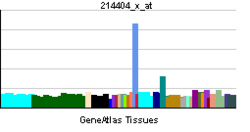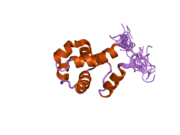SPDEF
| View/Edit Human | View/Edit Mouse |
SAM pointed domain-containing Ets transcription factor is a protein that in humans is encoded by the SPDEF gene.[3][4][5]
PDEF is an ETS transcription factor expressed in prostate epithelial cells. It acts as an androgen-independent transactivator of PSA (MIM 176820) expression.[supplied by OMIM][5]
Interactions
SPDEF has been shown to interact with NKX3-1.[6]
The Protein Kinase CK2 has been shown to control the stability of PDEF.[7]
References
- ↑ "Human PubMed Reference:".
- ↑ "Mouse PubMed Reference:".
- ↑ Oettgen P; Finger E; Sun Z; Akbarali Y; Thamrongsak U; Boltax J; Grall F; Dube A; Weiss A; Brown L; Quinn G; Kas K; Endress G; Kunsch C; Libermann TA (February 2000). "PDEF, a novel prostate epithelium-specific ets transcription factor, interacts with the androgen receptor and activates prostate-specific antigen gene expression". J Biol Chem. 275 (2): 1216–25. doi:10.1074/jbc.275.2.1216. PMID 10625666.
- ↑ Johannessen JV; Finseth I (July 1983). "Electron micrographs in five minutes". Ultrastruct Pathol. 4 (1): 97–100. doi:10.3109/01913128309140576. PMID 6857767.
- 1 2 "Entrez Gene: SPDEF SAM pointed domain containing ets transcription factor".
- ↑ Chen, Hui; Nandi Asit K; Li Xiang; Bieberich Charles J (January 2002). "NKX-3.1 interacts with prostate-derived Ets factor and regulates the activity of the PSA promoter". Cancer Res. United States. 62 (2): 338–40. ISSN 0008-5472. PMID 11809674.
- ↑ Chisholm, Christine; Padmanabhan Achuth; Guan Bin; Li Xiang; Kalra Simran; Bieberich Charles J (2010). "Protein Kinase CK2 regulates the stability of prostate derived Ets factor". The Open Cancer Journal. Bentham Science. 3: 109–115. doi:10.2174/1874079001003010109.http://www.benthamscience.com/open/tocj/articles/V003/SI0022TOCJ/109TOCJ.pdf
Further reading
- Lance V (1976). "Studies on the annual reproductive cycle of the female cobra, Naja naja. Seasonal variation in plasma inorganic ions.". Comparative Biochemistry and Physiology A. 53 (3): 285–9. doi:10.1016/S0300-9629(76)80037-0. PMID 2437.
- Yamada N; Tamai Y; Miyamoto H; Nozaki M (2000). "Cloning and expression of the mouse Pse gene encoding a novel Ets family member.". Gene. 241 (2): 267–74. doi:10.1016/S0378-1119(99)00484-9. PMID 10675039.
- Chen H; Nandi AK; Li X; Bieberich CJ (2002). "NKX-3.1 interacts with prostate-derived Ets factor and regulates the activity of the PSA promoter.". Cancer Res. 62 (2): 338–40. PMID 11809674.
- Strausberg RL, Feingold EA, Grouse LH, et al. (2003). "Generation and initial analysis of more than 15,000 full-length human and mouse cDNA sequences.". Proc. Natl. Acad. Sci. U.S.A. 99 (26): 16899–903. doi:10.1073/pnas.242603899. PMC 139241
 . PMID 12477932.
. PMID 12477932. - Thompson HG, Harris JW, Wold BJ, et al. (2003). "p62 overexpression in breast tumors and regulation by prostate-derived Ets factor in breast cancer cells.". Oncogene. 22 (15): 2322–33. doi:10.1038/sj.onc.1206325. PMID 12700667.
- Feldman RJ, Sementchenko VI, Gayed M, et al. (2003). "Pdef expression in human breast cancer is correlated with invasive potential and altered gene expression.". Cancer Res. 63 (15): 4626–31. PMID 12907642.
- Mungall AJ, Palmer SA, Sims SK, et al. (2003). "The DNA sequence and analysis of human chromosome 6.". Nature. 425 (6960): 805–11. doi:10.1038/nature02055. PMID 14574404.
- Ghadersohi A, Odunsi K, Lele S, et al. (2004). "Prostate derived Ets transcription factor shows better tumor-association than other cancer-associated molecules.". Oncol. Rep. 11 (2): 453–8. doi:10.3892/or.11.2.453. PMID 14719083.
- Gerhard DS, Wagner L, Feingold EA, et al. (2004). "The status, quality, and expansion of the NIH full-length cDNA project: the Mammalian Gene Collection (MGC).". Genome Res. 14 (10B): 2121–7. doi:10.1101/gr.2596504. PMC 528928
 . PMID 15489334.
. PMID 15489334. - Chen H; Bieberich CJ (2005). "Structural and functional analysis of domains mediating interaction between NKX-3.1 and PDEF.". J. Cell. Biochem. 94 (1): 168–77. doi:10.1002/jcb.20297. PMID 15523673.
- Wang Y, Feng L, Said M, et al. (2005). "Analysis of the 2.0 A crystal structure of the protein-DNA complex of the human PDEF Ets domain bound to the prostate specific antigen regulatory site.". Biochemistry. 44 (19): 7095–106. doi:10.1021/bi047352t. PMID 15882048.
- Fowler M, Borazanci E, McGhee L, et al. (2006). "RUNX1 (AML-1) and RUNX2 (AML-3) cooperate with prostate-derived Ets factor to activate transcription from the PSA upstream regulatory region.". J. Cell. Biochem. 97 (1): 1–17. doi:10.1002/jcb.20664. PMID 16237704.
- Gunawardane RN, Sgroi DC, Wrobel CN, et al. (2006). "Novel role for PDEF in epithelial cell migration and invasion.". Cancer Res. 65 (24): 11572–80. doi:10.1158/0008-5472.CAN-05-1196. PMC 2919290
 . PMID 16357167.
. PMID 16357167. - Rodabaugh KJ, Mhawech-Fauceglia P, Groth J, et al. (2007). "Prostate-derived Ets factor is overexpressed in serous epithelial ovarian tumors.". Int. J. Gynecol. Pathol. 26 (1): 10–5. doi:10.1097/01.pgp.0000225386.41244.bd. PMID 17197890.
- Park KS, Korfhagen TR, Bruno MD, et al. (2007). "SPDEF regulates goblet cell hyperplasia in the airway epithelium.". J. Clin. Invest. 117 (4): 978–88. doi:10.1172/JCI29176. PMC 1810569
 . PMID 17347682.
. PMID 17347682.
This article is issued from Wikipedia - version of the 6/29/2016. The text is available under the Creative Commons Attribution/Share Alike but additional terms may apply for the media files.





